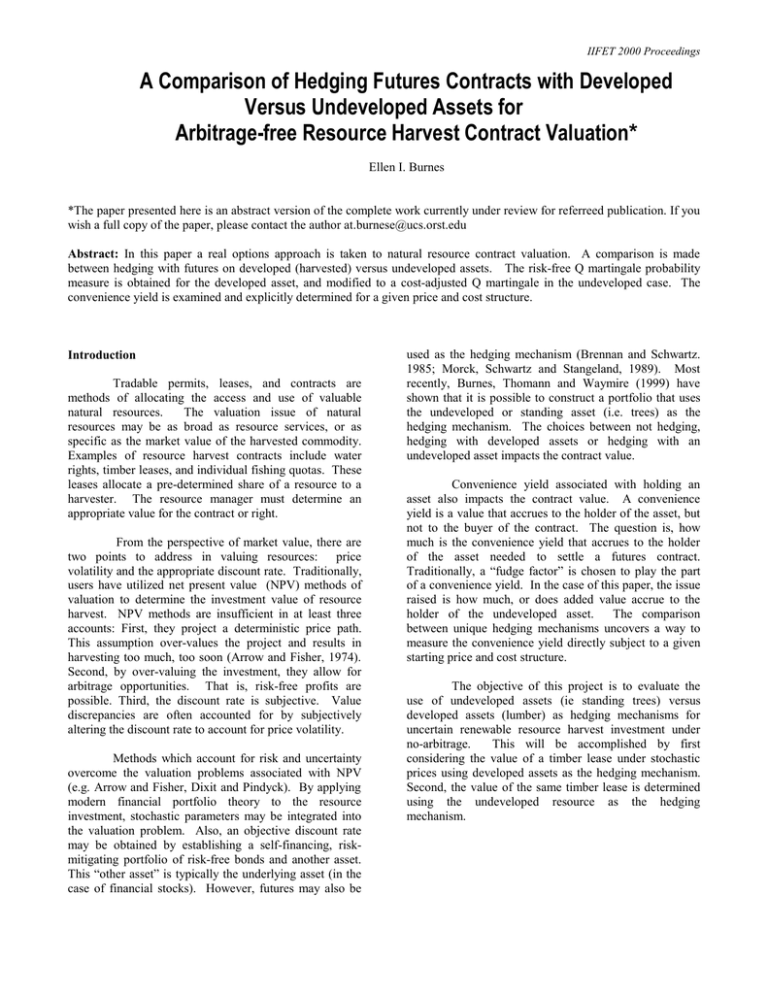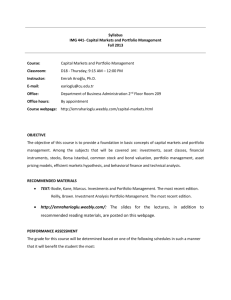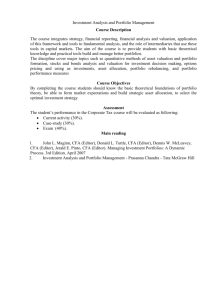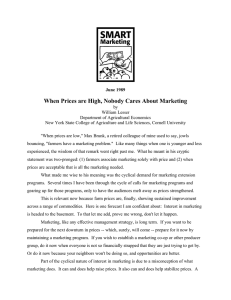A Comparison of Hedging Futures Contracts with Developed
advertisement

IIFET 2000 Proceedings A Comparison of Hedging Futures Contracts with Developed Versus Undeveloped Assets for Arbitrage-free Resource Harvest Contract Valuation* Ellen I. Burnes *The paper presented here is an abstract version of the complete work currently under review for referreed publication. If you wish a full copy of the paper, please contact the author at.burnese@ucs.orst.edu Abstract: In this paper a real options approach is taken to natural resource contract valuation. A comparison is made between hedging with futures on developed (harvested) versus undeveloped assets. The risk-free Q martingale probability measure is obtained for the developed asset, and modified to a cost-adjusted Q martingale in the undeveloped case. The convenience yield is examined and explicitly determined for a given price and cost structure. Introduction Tradable permits, leases, and contracts are methods of allocating the access and use of valuable natural resources. The valuation issue of natural resources may be as broad as resource services, or as specific as the market value of the harvested commodity. Examples of resource harvest contracts include water rights, timber leases, and individual fishing quotas. These leases allocate a pre-determined share of a resource to a harvester. The resource manager must determine an appropriate value for the contract or right. From the perspective of market value, there are two points to address in valuing resources: price volatility and the appropriate discount rate. Traditionally, users have utilized net present value (NPV) methods of valuation to determine the investment value of resource harvest. NPV methods are insufficient in at least three accounts: First, they project a deterministic price path. This assumption over-values the project and results in harvesting too much, too soon (Arrow and Fisher, 1974). Second, by over-valuing the investment, they allow for arbitrage opportunities. That is, risk-free profits are possible. Third, the discount rate is subjective. Value discrepancies are often accounted for by subjectively altering the discount rate to account for price volatility. Methods which account for risk and uncertainty overcome the valuation problems associated with NPV (e.g. Arrow and Fisher, Dixit and Pindyck). By applying modern financial portfolio theory to the resource investment, stochastic parameters may be integrated into the valuation problem. Also, an objective discount rate may be obtained by establishing a self-financing, riskmitigating portfolio of risk-free bonds and another asset. This “other asset” is typically the underlying asset (in the case of financial stocks). However, futures may also be used as the hedging mechanism (Brennan and Schwartz. 1985; Morck, Schwartz and Stangeland, 1989). Most recently, Burnes, Thomann and Waymire (1999) have shown that it is possible to construct a portfolio that uses the undeveloped or standing asset (i.e. trees) as the hedging mechanism. The choices between not hedging, hedging with developed assets or hedging with an undeveloped asset impacts the contract value. Convenience yield associated with holding an asset also impacts the contract value. A convenience yield is a value that accrues to the holder of the asset, but not to the buyer of the contract. The question is, how much is the convenience yield that accrues to the holder of the asset needed to settle a futures contract. Traditionally, a “fudge factor” is chosen to play the part of a convenience yield. In the case of this paper, the issue raised is how much, or does added value accrue to the holder of the undeveloped asset. The comparison between unique hedging mechanisms uncovers a way to measure the convenience yield directly subject to a given starting price and cost structure. The objective of this project is to evaluate the use of undeveloped assets (ie standing trees) versus developed assets (lumber) as hedging mechanisms for uncertain renewable resource harvest investment under no-arbitrage. This will be accomplished by first considering the value of a timber lease under stochastic prices using developed assets as the hedging mechanism. Second, the value of the same timber lease is determined using the undeveloped resource as the hedging mechanism. IIFET 2000 Proceedings by a unit d. In either case, the risk free bond moves with certainty by an increment r, the risk free discount rate. The relationship u>r>d is assumed throughout. That is: Methods The “usual” valuation approach is to look at the probabilities of various outcomes and then take an expectation of the price at a future time period. Once this expectation is formed, one must choose the appropriate discount rate with which to bring this expected value into current terms. This practice results in an arbitrage opportunity. Instead, hedge portfolios are constructed, providing a risk-neutral probability measure, called Q, under which we can make our expectations of future prices. Q represents the evolution of the discounted value of the underlying as a martingale, which is a change of measure from the expectations under the actual price process. The measure Q is further modified to Q(c) to accommodate the undeveloped resource case. W1 ­MS 0 u <B0 r V1 (u ) ® ¯MS 0 d <B0 r V1 (d ) (1) Now subtract V1(d) from V1(u) and solve algebraically for M and < . Equating the outcomes under the up and down cases makes the investor indifferent between up and down movements. That is, the proportions M and < determined by equating the outcomes in the next period, establish that the payoff of portfolio the portfolio matches the payoff of the investment in either the up or down case. The Hedging Portfolios The hedging mechanisms are derived to provide an understanding of how the market tools of assets, futures and bonds are used to derive risk-neutral, arbitrage free expectations. Using these instruments, the contract writer determines the value of the contract, and then uses that money to buy a designated amount of stocks and bonds to effectively hedge loss exposures. The proportion of the portfolio held in stocks and bonds may be traded continuously as asset prices change. The outcome of this portfolio is such that when the contract is exercised, the writer has enough to buy the asset, and pay off any borrowings (bonds), and the payoff to the writer is exactly zero. W0 s ª §rd · § u r ·º 1 «V1 (u )¨ u d ¸ V1 (d )¨ u d ¸» r © ¹¼ © ¹ ¬ (after canceling). (2) That is, the value of the portfolio,W0s is a function of the value of the portfolio in the up case (V1(u)), times the risk-neutral probability of the up case, plus the value of the portfolio in the down case (V1(d)), times the risk-neutral probability of the down case. These probability weightings are called risk-neutral martingale probability measures. Notice that they are only functions of magnitude of the changes in value. Given the Markov processes underlying the initial discrete models, the magnitude of value changes are constant over time. Two portfolio scenarios are considered. The first scenario is the traditional Black-Scholes binomial option pricing formula. In this case, the hedge portfolio is comprised of the underlying financial stock and risk-free bonds. Second, the hedge portfolio using the standing resource is derived. Hedging with the Undeveloped Asset The same process is utilized as in the preceding case to construct the hedge portfolio using the undeveloped asset. Here we obtain the measure Q(c) instead of the traditional Q. The portfolio is different in that W0 (c ) M ( S 0 c ) <B0 (c= the conversion Hedging with the underlying stock An option is the right to buy ( a call) or sell (a put) a stock for a pre-specified price in the future. A futures contract stipulates a date and price at which the stock must be bought. In either case, question is, how much should I pay a stock in the future. That is, what is the value of the portfolio: W0 s MS 0 <B0 . In cost). In this case we use current prices of timber minus harvesting costs as the value of the undeveloped asset. That is current timber price minus harvesting cost equals the value of the standing resource. The proportion of M and < in this case make the value of the portfolio equal to: words, the value at time zero of the hedge portfolio using stocks (W0s) , is a proportion. M , of the underlying stock (S) valued at time 0, and a proportion, < , of risk-free bonds (B) valued at time zero. In the next time period, the value of the stock can either go up by a unit u or down 2 IIFET 2000 Proceedings ª §rd c §1r ·· §ur c § r1··º1 W0R «V1(u)¨¨ ¨ ¸¸¸V1(d)¨¨ ¨ ¸¸¸» ©ud S0 ©ud¹¹¼r ¬ ©ud S0 ©ud¹¹ (3) the by not cutting until then ($10*.06=$.60). This is the "convenience yield" of holding the $10. Results The implication of the existence of a convenience yield is that the $53 for a contract to deliver a developed resource is actually too high. $53 assumes that there is no convenience yield associated with holding the harvested asset. Actually, there is since the holder of the asset may capitalize on shortages and higher than expected prices. The risk free rate r, must be adjusted by a measure / to account for this possibility. In this section, the value of each contract is derived, and an example is provided to clarify how the hedge portfolio is determined to maintain a risk neutral position for the contract writer. A risk neutral position means that the writer is indifferent between upward and downward price movements. Table 2 depicts the hedging relationships occurring in the 3 valuation cases: If the convenience yield equals / , the portfolio representation of this process is as follows: Hedging Method Forward Contract (the deliverable) Contract Value Lumber lumber $53 Trees trees $42.40 Trees lumber $52.40 W1cy ­°) (uS 0 u/S 0 ) )u/S 0 <rB0 ® °̄) (dS 0 d/S 0 ) )d/S 0 <rB0 V1u cy V1d cy (4) Combining the payoffs of the binomial tree above with the portfolio’s first time-step results we get: Table 2: Contract Values under Various Hedging Methods W1cy In the first row, the value of the contract today is V0=MS0-c) + <B0. By simultaneously solving the outcomes in period 1, we get M 1. We also know that V0=0 since no money is exchanged in period 0 in the case of futures. We have also already derived < in equation (7) as -k/rB0. For simplicity, let B0=1. Therefore we have, 0=S0-c-k/r. That is 40(1.06)=k=$42.40, the amount the writer (the Forest Service) should receive in the next period. The writer borrows $40 at the risk-free rate today, and in the next period turns over the trees to harvest, receives $42.40 and pays back the bond loan. Notice that the traded asset and the hedging asset are both undeveloped assets. ­°) (uS 0 u/S 0 ) )u/S 0 <rB0 ® °̄) (dS 0 d/S 0 ) )d/S 0 <rB0 V1ucy V1dcy (5) Since W0(c), S0 and r are given, it is possible to 1 W0 ( c ) . Given the r S0 specifications in this example, / =.0113 (Note that / is derive / . Namely, / 1 S0 dependent, as Morck, Schwartz and Stangeland suggest). In summary, the results of this comparison indicate that a harvested contract hedged with futures on a harvested resource will be overvalued if a convenience yield is not considered. By hedging with the unharvested resource, we are able to replicate the payoff of the developed resource and determine a convenience yield measure. By incorporating this measure into the contract valuation an arbitrage-free valuation of the harvesting contract is obtained. In the second row, standing trees are used to hedge a futures contract to deliver harvested trees. The bidder agrees to buy the government contract for standing trees at $42.40 in the next period. This party must harvest these trees next period at a cost of $10. Therefore, the total costs which accrue to the party are $52.40. However, the party may also contract with "another" to buy harvested trees. We have already shown that the appropriate amount to charge for harvested trees hedged with harvested trees is $53. Next period the bidder earns $.60 or the interest earned on the $10 between today and 3 IIFET 2000 Proceedings Conclusions and Policy Implications These results have policy implications for resource managers interested in setting contract rates for natural resources such as trees, fish and water. First, in the cost adjusted case, we can directly see the impact that costs have on the contract price. In instances where harvester costs are uncertain, managers can better model the impact that cost variations across harvesters may have on contract values. Second, using the risk-neutral case allows managers to use an objective interest rate measure (the risk free interest rate) in discounting contract values over time. Third, these results provide a market-based foundation for integrating non-market resources into a valuation system. These results are strictly based on observable market characteristics of prices and hedging opportunities. If one wishes to value social and resource derived from different policy scenarios, these values suggest a starting value in the absence of public or environmental welfare. This framework provides a method for setting a reliable and justifiable benchmark for the value of undeveloped natural resources. LITERATURE CITED Arrow, Kenneth and Anthony Fisher. 1974. Environmental Preservation, Uncertainty and Irreversibility. Quarterly Journal of Economics. vol. 88, no. 2. pp. 312-319. Brennan, Michael and Eduardo Schwartz.1985. Evaluating Natural Resource Investments. Journal of Business. vol 58, no. 2. pp. 135-57. Burnes, Ellen, Enrique Thomann and Edward C. Waymire. 1999. Arbitrage Free Valuation of a Forest Science. Federal Timber Lease. November. Dixit, Avinash and Robert Pindyck. 1994. Investment Under Uncertainty. Princeton University Press. pp. 468. Morck, Randall, Eduardo Schwartz and David Stangeland. 1989. The Valuation of Forestry Resources under Stochastic Prices and Journal of Financial and Inventories. Quantitative Analysis. vol 24, no. 4. Pp. 473487. Thomann, Enrique and Edward C. Waymire. 2000. A Black-Scholes-Merton Equation with Conversion Costs. pre-print. 4





